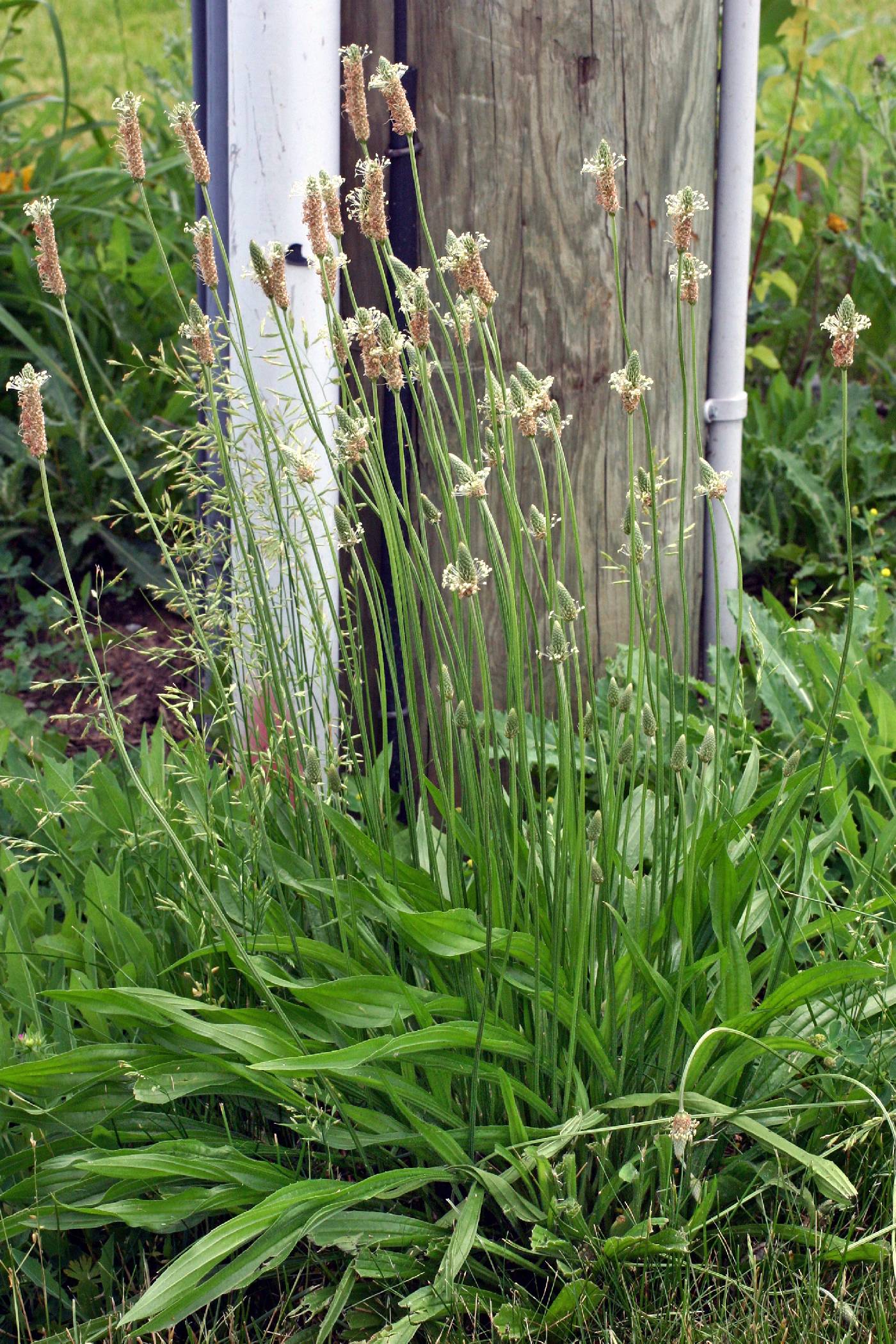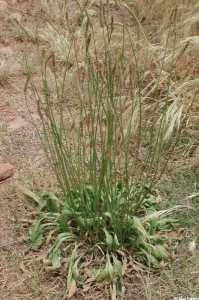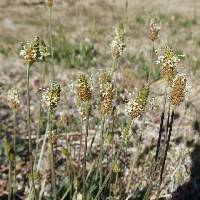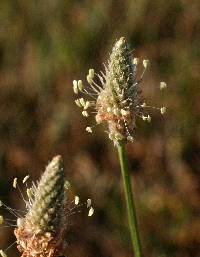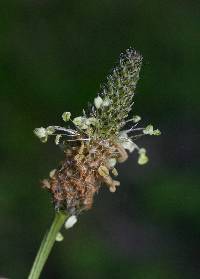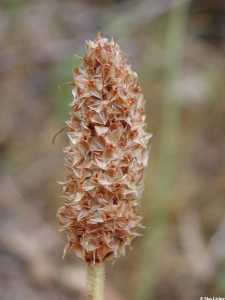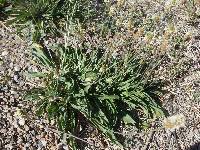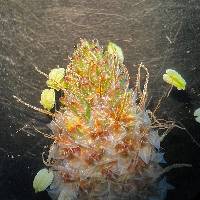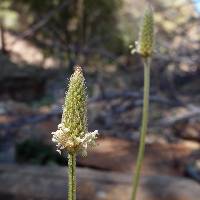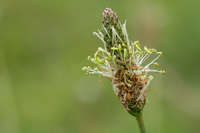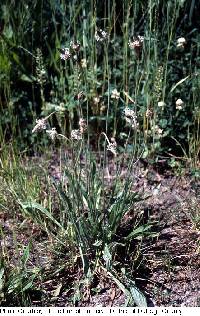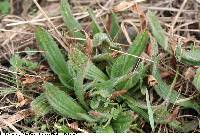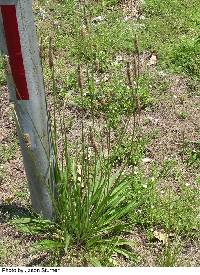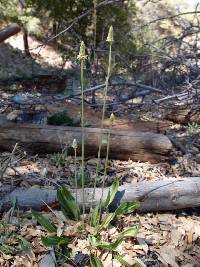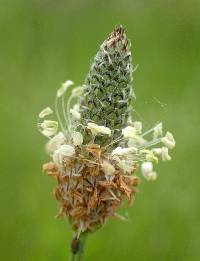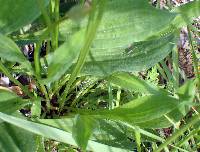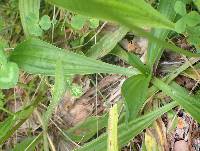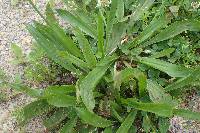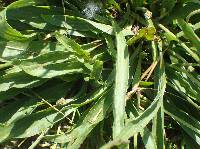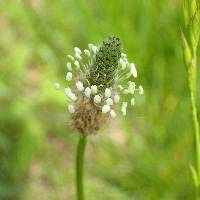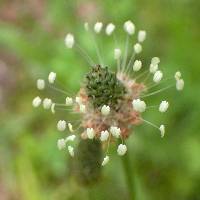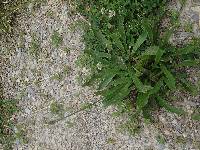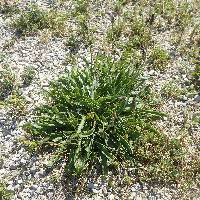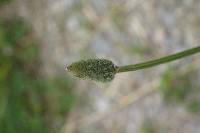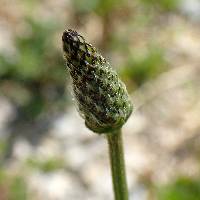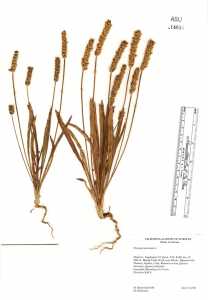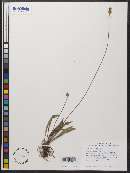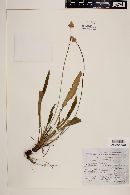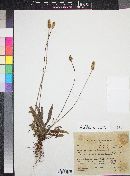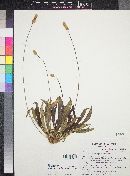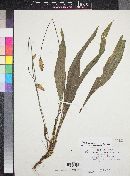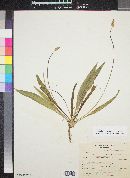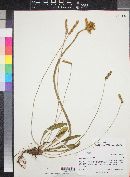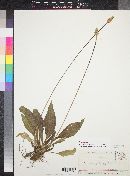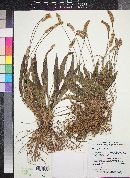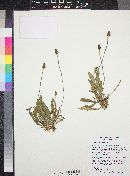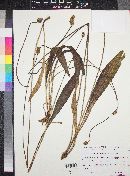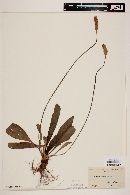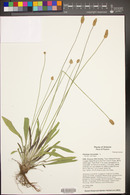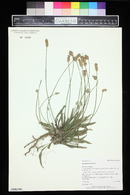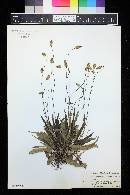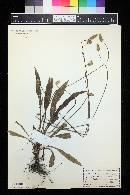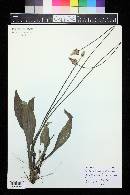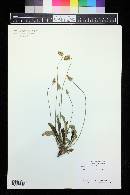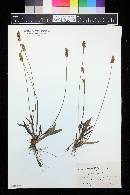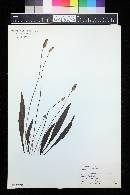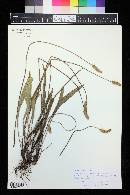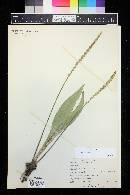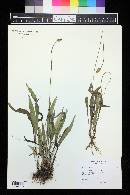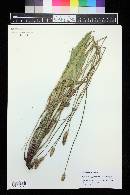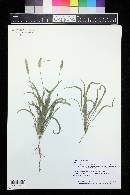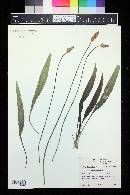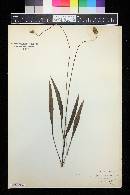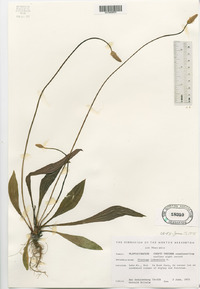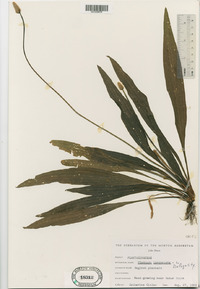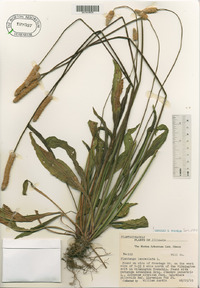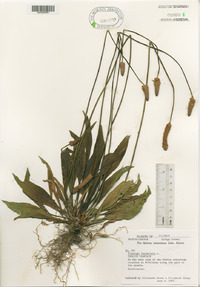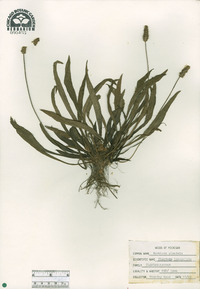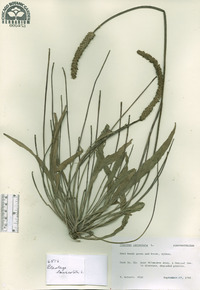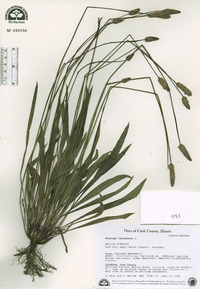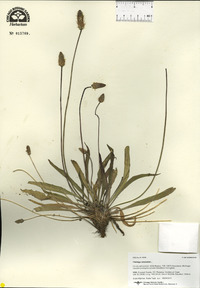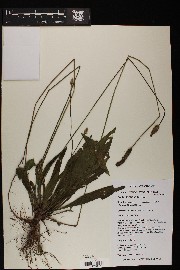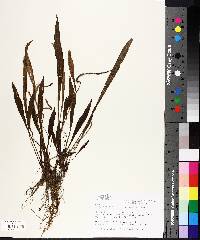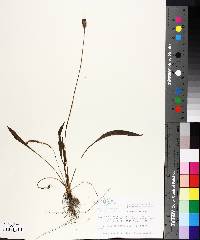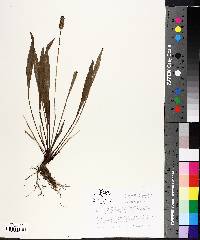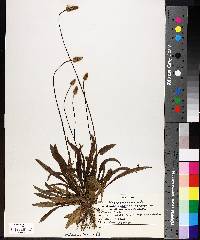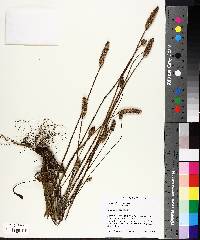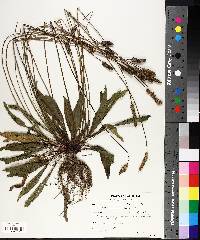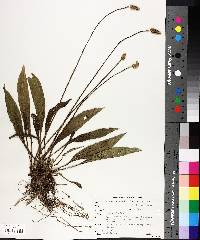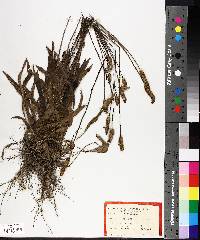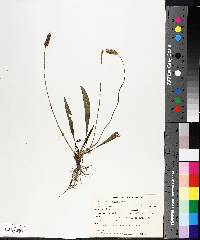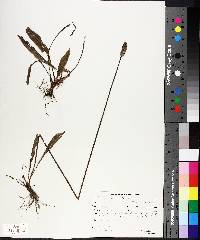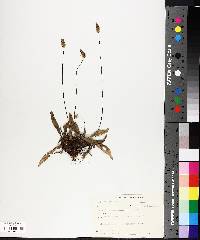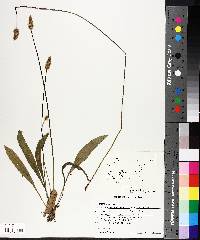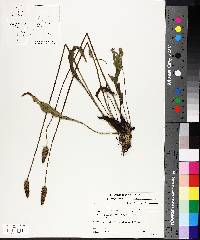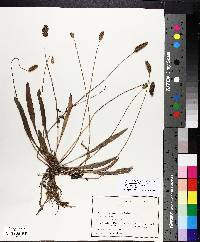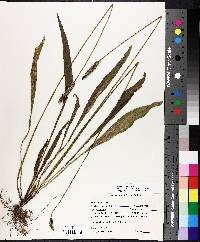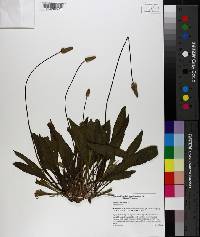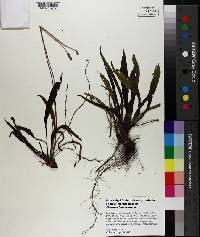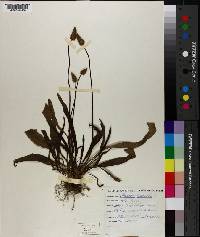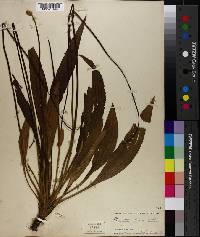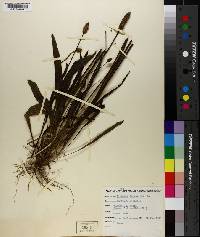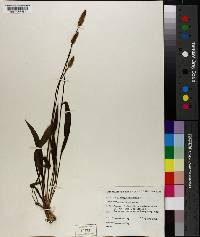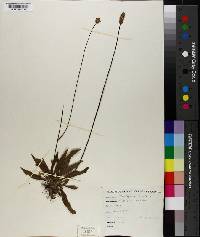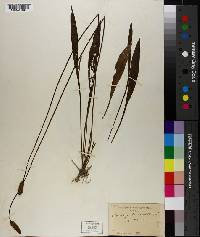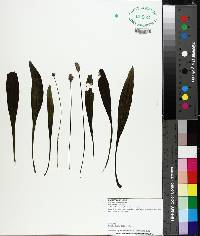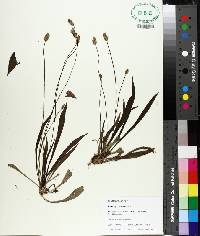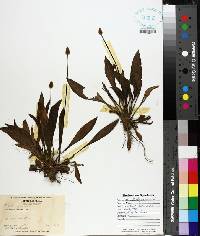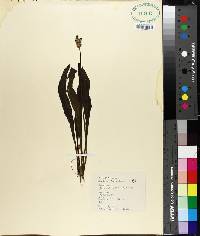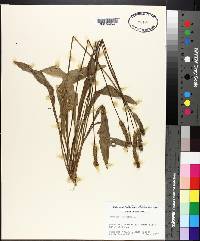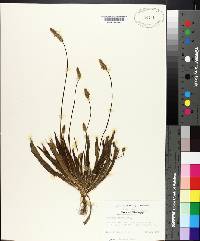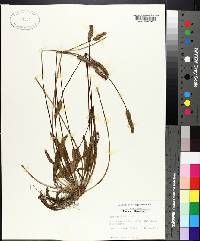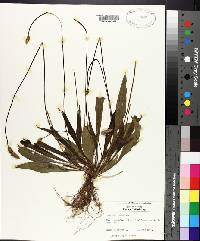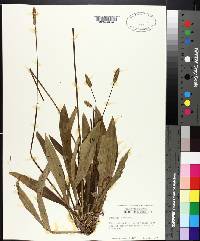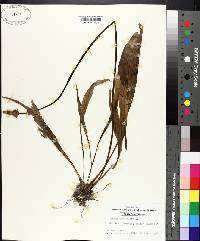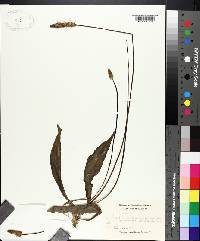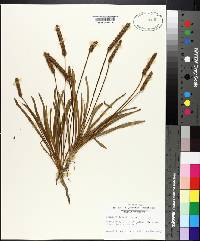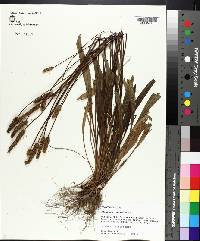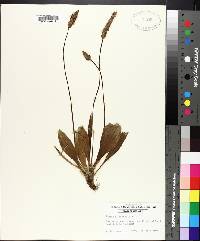Plantago lanceolata
|
|
|
|
Family: Plantaginaceae
English Plantain, more...narrowleaf plantain, buckhorn plantain, lanceleaf Indianwheat, lanceleaf plantain, ribgrass, ribwort
[Plantago abyssinica Hochst. ex A. Braun, morePlantago altissima auct. non L., Plantago hungarica Waldst. & Kit., Plantago lanceolata var. sphaerostachya Mert. & Koch] |
Plant: Perennial herb; to 65 (-85) cm tall Leaves: petiolate; blades lanceolate, 4-24.5 cm long, 0.5-4.2 cm wide, long attenuate at base, acute at apex, sparsely pubescent to glabrate, distinctly 5 (-7)-veined, with margins occasionally having a few, remote teeth INFLORESCENCE: pedunculate, scapose; PEDUNCLES 13-86 cm, strigose. SPIKES 1.5-7 cm long; bracts broadly triangular, (1.5-) 2 mm long Flowers: perfect; sepals obovate, 1.5-2.5 mm long, broadly scarious-margined, the 2 outermost characteristically fused, appearing as a solitary, 2-veined, apically notched or entire sepal; midvein thin, ciliate at apex; corolla lobes spreading or reflexed, subulate to narrowly ovate, 2-2.5 mm long; stamens 4 Fruit: capsules, breaking well below middle; SEEDS 2, ellipsoid, concave, 1.5-2.5 mm long, ca 1.0 mm wide, brown, the outer surface shiny Misc: Moist soils; 950-2450 m (3200-8200 ft); May-Aug. This species may be confused with P. tweedyi and P. eriopoda vegetatively but is easily differentiated when flowers or fruits are present by the two connate sepals. The high elevation collections from Yavapai and Gila counties appear to be more densely pubscent than those collected from lower elevations. REFERENCES: Huisinga, Kristin D. and Tina J. Ayers. 1999. Plantaginaceae. Ariz. - Nev. Acad. Sci. 32(1). Perennial herb with fibrous roots flowering stem 15 cm - 0.6 m tall Leaves: basal, ascending, 10 - 40 cm long, 1 - 4 cm wide, narrowly elliptic to lance-elliptic with a tapering base and long-pointed tip, strongly parallel-veined, sometimes hairy. Inflorescence: a dense, egg- to cone-shaped or cylindrical spike of many flowers, arising from a leafless stalk (scape), 1.5 - 8 cm long, about 1 cm wide. Flowers: stalkless or nearly stalkless, greenish to yellowish, about 5 mm wide, subtended by thin, egg-shaped bracts. Stamens four, much exserted, alternate with corolla lobes. Style one. Sepals: four, green, hairy-margined, outer two merged together with separate midveins, 3 - 3.5 mm long. Fruit: a dehiscent capsule (circumscissile), 3 - 4 mm wide. Seeds one or two, shiny blackish, about 2 mm long, deeply concave on one side. Corolla: four-lobed, greenish to yellowish, about 5 mm wide, scarious (dry, thin, membranous). Lobes spreading or reflexed, 2 - 2.5 mm long. Similar species: The five-grooved scape, lance-shaped leaves, and shape of the inflorescence help distinguish this species. Flowering: May to late September Habitat and ecology: Introduced from Europe. A common weed of lawns and waste ground. Occurence in the Chicago region: non-native Etymology: Plantago comes from the Latin word planta, meaning footprint. Lanceolata means lance-shaped. Author: The Morton Arboretum Huisinga and Ayers 1999 Duration: Perennial Nativity: Non-Native Lifeform: Forb/Herb General: Acaulescent perennial, with spirally arranged rosette, to 90 cm tall. Leaves: On petiole, blades lanceolate, 4-24.5 cm long, 0.5-4.2 cm wide, long attenuate at base, acute at apex, sparsely pubescent to glabrate, distinctly 5 veined, with margins occasionally having a few, remote teeth. Flowers: On peduncles 13-90 cm, strigose, topped with a terminal spike 1.5-7 cm long, bracts broadly triangular, 2 mm long, the flowers perfect, obovate sepals, 1.5-2.5 mm long, broadly scarious-margined, outermost characteristically fused, appearing as solitary, 2-veined, apically notched or entire; midvein thin, ciliate at apex, corolla lobes spreading or reflexed, subulate to narrowly ovate, 2-2.5 mm long, 4 stamens. Fruits: Circumsessile capsule breaking well below middle. Ecology: Found in moist soils from 3,000-8,500 ft (914-2591 m); flowers May-August. Notes: Can be confused with P. tweedyi and P. eriopoda but told apart by the two connate sepals, when flowers or fruits are present. Ethnobotany: Used for headaches, used for dysentery, for poisonous bites, stings, snakebites, applied to burns, used for blisters, sore eyes, used orally, internally for bowel complaints, earaches, and as fodder for cattle. Etymology: Plantago translates to foot-sole in reference to leaf habit on ground, while lanceolata means lance-shaped Synonyms: Plantago altissima, Plantago lanceolata var. sphaerostachya Editor: SBuckley, 2010 Fibrous-rooted perennial with a stout erect caudex, often flowering the first year, ±tan-woolly at the crown; lvs usually ascending, villous to glabrous, 3-several- nerved, narrowly elliptic or lance-elliptic, long-acute, 1-4 dm נ1-4 cm; scapes strongly 5-sulcate, strigose above, 1.5-6 dm; spikes very dense, ovoid-conic at first, at maturity cylindric, 1.5-8 cm נnearly or fully 1 cm; bracts thin, ovate, broadly scarious-margined, often caudate-tipped; sep often villous-ciliate toward the tip of the strong midnerve, the 2 outer connate with separate midveins, merely notched at the tip, or entire; cor-lobes 2-2.5 mm, spreading or reflexed; fr 3-4 mm, circumscissile near the base, the (1)2 seeds shining, blackish, 2 mm, deeply concave on the adaxial face; some fls or plants sometimes pistillate; 2n=12. Native of Eurasia, now a cosmopolitan weed, particularly in moister parts of the temperate zone, common in lawns and along roadsides. Gleason, Henry A. & Cronquist, Arthur J. 1991. Manual of vascular plants of northeastern United States and adjacent Canada. lxxv + 910 pp. ©The New York Botanical Garden. All rights reserved. Used by permission. From Flora of Indiana (1940) by Charles C. Deam A pernicious weed found throughout the state. It is especially troublesome in clover fields because the seed are separated with difficulty from the clover seed. A farmer in Perry County, however, told me that the young plants are much relished by stock, and he said that he always sowed the seed in his pastures to increase the forage. It is found in cleared grounds almost everywhere except in very sandy or very wet soils. [Deam recognized var. sphaerostachya which he described as having more subglobose spikes and leaves with abundant, long hairs on the upper surface.] I found this form as a frequent plant in a pasture field on the east side of Pleasant Lake, Noble County, and a few specimens on the sandy bank of the north side of Simonton Lake, Elkhart County. …… Indiana Coefficient of Conservatism: C = null, non-native Wetland Indicator Status: FACU |
|
|
|

